Cave Keeper
Shiny_Rock
- Joined
- Jun 30, 2004
- Messages
- 264
----------------
On 10/13/2004 1:19:56 PM Michael_E wrote:
Which are your favorites ? ----------------

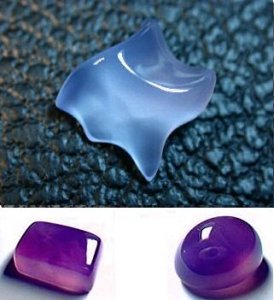
----------------
On 10/13/2004 1:19:56 PM Michael_E wrote:
Cave Keeper,
Agate is cryptocrystalline quartz. This means that it is composed of microscopic quartz crystals that all formed at the same time, or at least each layer within it formed at the same time. It's tought that the layers hardened from silica gels that became harder and more crystalline as the temperature and or water content lowered. I don't think that agate could be very magnetic since magnetism requires a high level of alignment among the iron or other magnetic metals that would be incorporated into the agate as impurities. Magnetic induction ? I don't know, sounds like a sales pitch. Normally inductive materials are metals and an agate would need a lot of impurities to get there, but who knows, could happen I suppose. 5% Tektite ? Only if the tektite were ground to microscopic bits and incorporated into the micro-crystalline structure of the agate. Natural agate without impurities is white since it is just a whole bunch of little quartz crystals stuck together. The impurities are what makes it attractive. Nickel salts in Chrysoprase, Iron oxides in carnelian, and who knows what in the fine blue agates. I think the most interesting are the fire agates which have layers of Iron oxide crystals which diffract and reflect light in an opalescent sort of display. Which are your favorites ? ----------------

----------------
On 10/14/2004 4:13:18 PM Michael_E wrote:
Cave Keeper,
This is funny, ' And there's a claim that dZi beads can have a magnetic force of 13 Watts compared with 4 watts for quartz crystals (I didn't know magnetic force is measured in Watts). The dZi beads are etched Agate beads, but there's even a claim they dropped out of the sky. Another claim is that they are from the ground and were living, but fossilized immediately when caught by humans.'
Although I'm not entirely skeptical of supernatural effects, (I just don't know on some claims), I am skeptical, when people fling around scientific jargon to support their claims. This one sounds like a really good sales pitch. Magnetism is measured in Gauss or if the field is more intense it's measured in Tesla units. Magnetism is a field, it is not power, which is what the units of watts represents. Quartz cyrstals are not magnetic under normal circumstances.
:
----------------
----------------
On 10/14/2004 4:13:18 PM Michael_E wrote:
I just love bright agates or better yet agates with intricate patterns. Almost as good as diamonds aren't they ?
----------------

----------------
On 10/13/2004 1:19:56 PM Michael_E wrote:
:
I think the most interesting are the fire agates which have layers of Iron oxide crystals which diffract and reflect light in an opalescent sort of display.
:
----------------
----------------
On 10/18/2004 8:14:16 AM Cave Keeper wrote:
I hope someone can post one or more images of fire agates, as I've no idea what they look like.----------------
----------------
Just seeing one fire agate image like the attachment won't tell you much. As Scott said above, agates (and the whole quartz family) are a gemology course in themselves. I'll post a few more images of finished stones below and look forward to seeing Scott's.
I polished this specimen while it was still attached to the host rock to illustrate how fire agate forms. The colorful thin layers of bright iron oxide (goethite) are deposited randomly through the brown botryoidal mass (botryoidal means 'like a bunch of grapes.') To finish it I'll eventually diamond-saw the polished section from the host rock, polish the bottom, then design a gold setting especially for this particular stone -- it certainly won't fit a standard mounting!
As with most gems, fire agate quality covers a huge range. There are many different colors, types, grades and "personalities," as with opal. In general, fire agate is a very much misunderstood and underappreciated gem. I spent years learning to cut it and, having cut most kinds of colored stones, can say that fire agate is by far the most difficult of them all! It requires carving skills along with normal lapidary techniques, and every finished stone is very hard won.
Fire agate is much more durable than opal (hardness 7 to 7.5 as opposed to 5.5 to 6) and it's much less brittle. Because of the way this particular agate occurs, jewelry usually must be made to fit the stone rather than forcing the stone into some preconceived shape. It's become a cliche lately in art jewelry circles, but this stone definitely tells you what it wants to be! If you ignore what it's telling you, the gem is ruined.
Anyhow I hope these images and others will provide more understanding of a truly fine gem. To date, notable fire agate deposits have been found only in the states of Arizona, New Mexico, California and portions of Mexico. It's also a "new" gem: prior to the late 1940s no one recognized its potential or knew how to cut it.
Richard M.
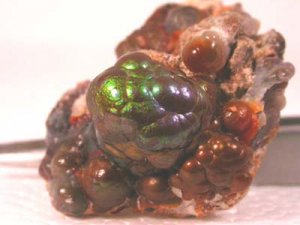
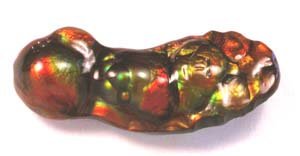
----------------
On 10/18/2004 4:58:04 PM firerock wrote:
The above reminded me of an AMMONITE.

This is what my mom loves and i've gotten her 3 pendants.
----------------
----------------
On 10/18/2004 7:20:09 PM Cave Keeper wrote:
I'm quite sure you're pulling our legs with that ammonite image, firerock.
I don't think so Cave Keeper. The image (which should have been credited) is direct from Korite International's web site. It shows a complete ammonite fossil before being cut into smaller gems. While complete fossils from the Alberta site tend to be fairly large, these creatures occurred in many sizes, from huge to tiny.
I have ammonite fossils from France that have been replaced by pyrite and are just a little bigger than a dime (image). Since I don't know how to stitch images together in PhotoShop, see the next post for a different type.
The big advantage of fire agate over Ammolite and opal is its hardness. Fire agate is Mohs 7 to 7.5; opal 6 to 6.5 and Ammolite 4.5. Also, Ammolite and opal are cut into assembled doublets and triplets and Ammolite is treated with epoxy resin to stabilize it. Fire agate is entirely untreated and is sold only as solid 100% natural stones.
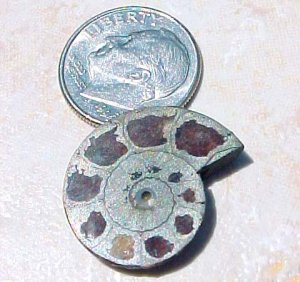
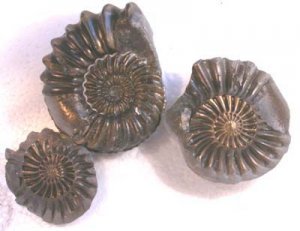


things get ? Until seeing this one below, I thought great fire agate comes only in fist-sized nodules...

----------------
On 10/18/2004 10:57:35 PM valeria101 wrote:
How big do these things get ? Until seeing this one below, I thought great fire agate comes only in fist-sized nodules...
----------------
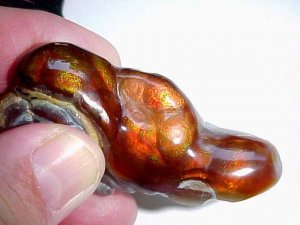
----------------
On 10/18/2004 10:52:37 PM firerock wrote:
Here is my mother's pendant I bought in Alaska. This will be for her Christmas gift. It is from Korite Int. Alberta. That perfect ammonite shell is from their website. I didn't mean to say that's what i bought for my mom. I know I couldn't afford THAT!!
sorry about the picture, i don't know how to make it smaller.

----------------
----------------
On 10/18/2004 7:31:03 PM firerock wrote:
I'm sorry Cave Keeper, I didn't mean to get you excited like that! (wink**wink) I should have been more clear about what i got my mother. Her pendants were not a whole shell piece like the pic i posted.
:
I saw a beauty piece that I couldn't pass up. It has all the colors on one piece. I will try to post a picture tonight.
----------------